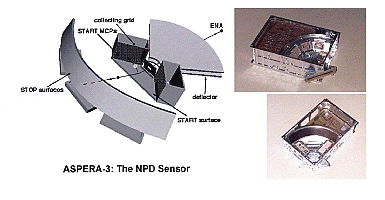|
ASPERA-3
Neutral Particle Detector (NPD)
 The Neutral Particle detector sensor consists of two identical
detectors, each of which is a pinhole camera. In each detector the
charged particles with energies up to 70 keV, electrons and ions, are
removed by the deflection system which consists of two 90° sectors
separated by a 4.5 mm gap. Apart from being ON or OFF the deflection
system can be operated in the alternative mode. The ENA beam emerging
from the 4.5 x 4.5-mm pin - hole hits the START surface under the
grazing angle 20° and causes the secondary electron emission. By a
system of collecting grids, the secondary electrons (SE) are
transported to one of two MCP assemblies giving the START signal for
the time-of-flight (TOF) electronics.
The Neutral Particle detector sensor consists of two identical
detectors, each of which is a pinhole camera. In each detector the
charged particles with energies up to 70 keV, electrons and ions, are
removed by the deflection system which consists of two 90° sectors
separated by a 4.5 mm gap. Apart from being ON or OFF the deflection
system can be operated in the alternative mode. The ENA beam emerging
from the 4.5 x 4.5-mm pin - hole hits the START surface under the
grazing angle 20° and causes the secondary electron emission. By a
system of collecting grids, the secondary electrons (SE) are
transported to one of two MCP assemblies giving the START signal for
the time-of-flight (TOF) electronics.
Depending on the azimuth angle the collection efficiency varies from
80% to 95%. The incident ENAs are reflected from the START surface
near-specularly. Since the charge state equilibrium is established
during the interaction with the surface, the emerging beam contains
both the neutral and ionized (positive and negative) components. To
increase the total efficiency, no further separation by the charge is
made. As proven by the ion tracing, there is very little disturbance
to the reflected atomic ions leaving the START surface with an energy
above 80 eV, introduced by the START electron optics. Therefore
particles of all charge states - negative, neutral, and positive -
will impact the second surface, the STOP surface, and again produce
secondary electrons which are detected by one of the three MCP
assemblies giving the STOP signal. The time of flight over the fixed
distance of 8 cm defines the particle velocity. The STOP MCPs also
give the azimuthal direction. Since the SE yield depends on mass for
the same velocity, the pulse height distribution analysis of the START
signals and independent analysis of the STOP signals provide the
estimation of ENA mass. Each event is stored in the array START MCP
charge x STOP MCP charge x time-of-flight x direction.
The UV suppression in NPD is based on the coincidence of START / STOP
signals. To increase the particle reflectivity, it is considered to
use very smooth (roughness is of the order of 5 - 10 Å) metal
surfaces. On the other hand the STOP surface is proposed to be made of
graphite (roughness around 100 nm) covered by MgO. This combination
has a very high secondary electron yield, low photoelectron yield and
high UV absorption. Both proposed surfaces are stable and do not
require special maintaining.
|
|
|
|
|
 |
|
|
|
|
